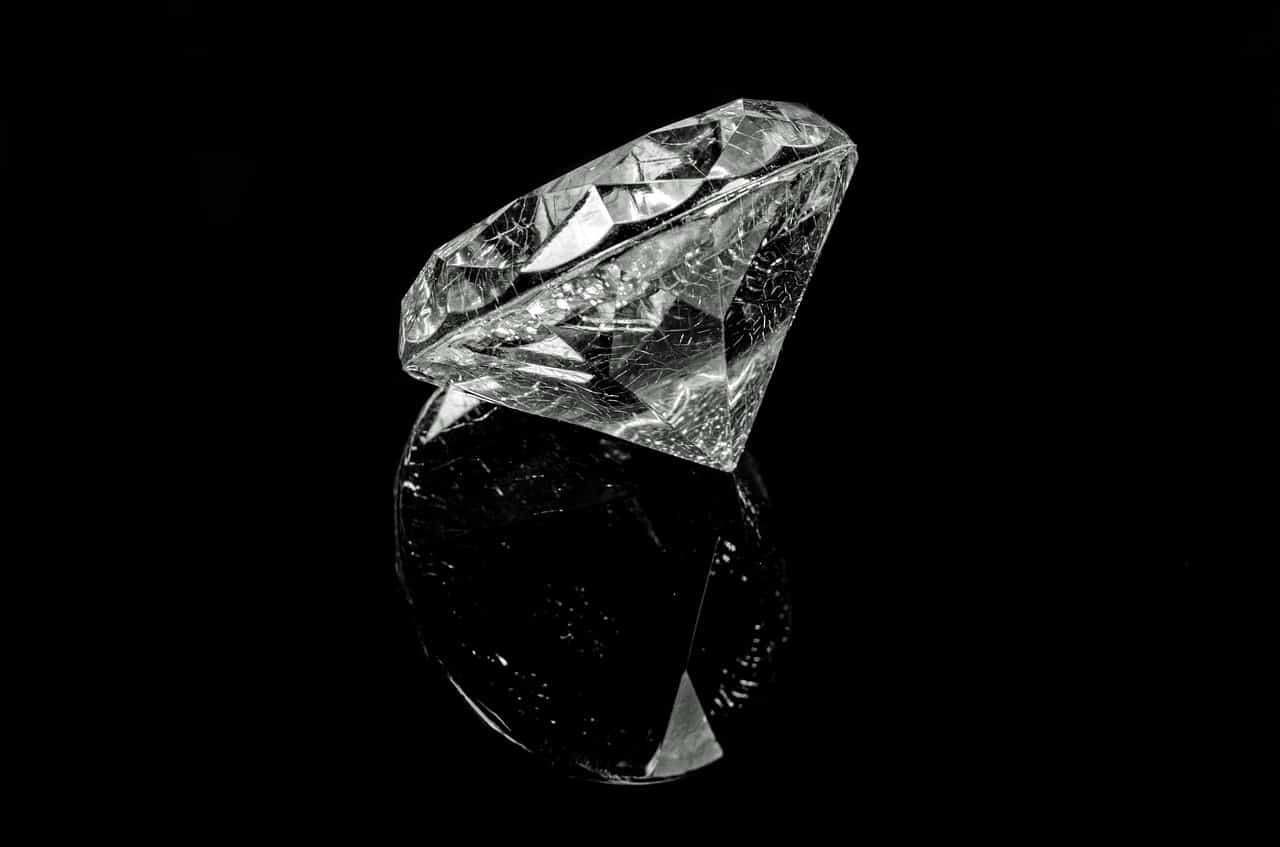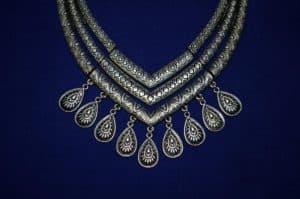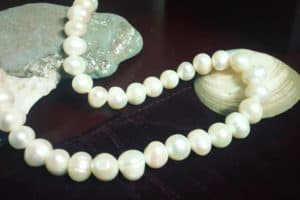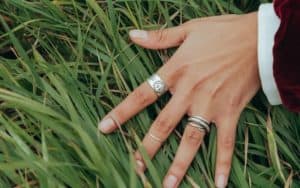Diamond is the hardest substance rating a perfect 10 on the moh’s scale. This makes it impossible to believe that it can chip. Surprisingly, it does not have to be hit by a very heavy and strong hammer for that. It is interesting to know that regular wear may subject your diamond to conditions and situations where it may chip.
A chipped diamond is not always worthless. In most cases, it is still worth some fraction of it’s original value. The fraction is determined by some factors. These include, the size of the diamond, the location of the chip, the intensity of damage and the quality of your diamond. We will discuss these in detail. But do not forget, a good, specialized jewelry insurance policy goes a long way in safeguarding the financial loss you may experience for having to replace a chipped diamond. It may be worth the original value if you have a good customized insurance plan for it.
Having said that, the actual probability of getting a diamond chipped is too narrow. Not every diamond will break or chip during regular wear. Just stay with us till the end, and we’ll take you through what a diamond owner needs to know.
Do diamonds shatter or chip?
Yes, while a diamond may not shatter into pieces like glass, it can certainly chip. The feather inclusions and the cleavage of a diamond play a crucial role in deciding how prone it may be to chipping. We will discuss these in detail later. Diamonds normally chip at the girdle and at the pointed protruded ends. This, to an extent, depends upon your upkeep and how cautious you are while wearing them. The probability of your diamond getting cracked or chipped depends on the quality of diamond and the cut as well. Some cuts are more prone to getting chipped than the others. E.g., Pearl, Marquise and heart shaped diamonds are more prone to chipping than others. The cracks could also be due to impurities present in the stone.
CAUSES OF CHIPPING
Can a diamond be chipped if dropped?
Yes, although diamonds are considered the hardest, they can chip when dropped. It is not likely that a diamond will certainly chip when dropped. But remember there is always an exception to it. The exposed outer edge, also known as the girdle, is the most vulnerable part.
If the gridle hits a sharp and hard object at the wrong angle (where the atom bonds are loose), with a lot of force, it might chip. Also, a diamond that is of inferior quality or has been weakened over time is more likely to chip than a premium quality or well cared for diamond.
Let us look at the ways your diamond may chip are:
- If it is bumped against any hard surface
Hard blows may be detrimental. If you accidentally hit your diamond ring against some hard surface at the cleavage plains. It might end up having chip(s) upon it.
- Being dropped
If there is pressure build up accumulated in your stone, and you drop the stone, it may chip. Unfortunately, it is not possible to identify or spot pressure build up in the stone. It is just accumulated pressure due to periodic blows to the stone.
- Setting the stone into jewelry
This happens at the jeweler. Even before you claim ownership of the diamond, there are possibilities of it getting chipped while setting it on the ring or neckalce with the intention to place and fix it at its place.
- Polishing and recutting
To deal with the existing chip, people tend to re-cut or polish their diamonds. But this trick may not always be useful as it degrades the diamond in size and, in turn, in value. It also poses the risk of mishappening like finishing mistakes which may lead to chipping or other kinds of damages.
- Claws of the jewelry
Claws are the hands that mount the diamond in its place in the jewelry. When these prongs break or bend, your diamond becomes prone to damage and getting chipped.
- Sudden high temperature
Here we’re talking about 1562 degrees Fahrenheit (850 degrees Celsius). This means a house fire can destroy your gemstone.
- Exposure to saltwater
Extended exposure to salt water can make your diamond weak over time. A weak diamond is more likely to chip from accidental blows. Therefore, it is always a good idea to remove your diamond jewelry before stepping into sea water.
When there is inbuilt stress in the diamond, it may simply break even with a gentle tap. If you dropped a diamond and are worried that it broke, fret not, it is not common for a diamond to chip. You can inspect your diamond carefully to look for any cracks or dents. Sometimes, what looks like a crack or dent to you is just dirt accumulated on the stone.
VALUE PROPOSITION OF A CHIPPED DIAMOND

How do you tell if the diamond is chipped?
Your best bet is to consult a diamond expert or your nearest trusted jeweler. But, there are ways you can inspect your diamond at home.
- Firstly, take a bowl and gently clean your diamond jewelry with mild soap water. Doing it in a bowl is better than doing it over a sink or any open surface as you may lose the diamond.
- Avoid using acetone, chlorin, baking soda, toothpaste or other chemicals to clean your diamond as they may prove to be damaging. Also be very careful if you are using any brush to clean your jewelry. The bristles may further damage the chip.
- Then rinse with clean water twice or thrice to remove any residue.
- Let them dry.
- Closely inspect the diamond. Use a magnifying glass to see the diamond clearly. Inspect the edges carefully as this is where most chips happen.
- Move your fingernails around and touch its facets and try to find any irregularities in the structure. Your fingernails might be able to feel any gap that is there. If you feel that a gap or crack at some place, inspect that area carefully. Do you see a white cloud or feather like thing there, your diamond is most likely chipped or cracked.
- In case you found something, confirm by getting it checked by a jewelry expert.
Are chipped diamonds worth anything?
Yes, although the value of the diamond drops, but you may still sell them for a fraction of amount. E.g., If you own a diamond of .5 carat, you can get anywhere between $600-$1200. It is a good idea to get your diamond inspected by a professional appraiser. They will help you understand the chip and it’s impact on the strength and quality of your diamond in detail. They can also tell you the range in which you can sell your diamond so that you get the best value for your stone.
The exact value depends on the below factors:
- The carat or weight of the diamond: High carat diamonds are expected to have a lower impact from chip. This is because, for a small diamond, a chip can cove most of the diamond and make it invaluable. However, a small chip won’t cause much damage to a higher carat diamond. Therefore, normally, higher the carat, better would be the price.
- The location of the chip: Some chips are easier to hide in jewelry designs and setting. If your chip can be covered, you will get a better value.
- The size: Bigger the chip, more cutting would be required to remove it and more visible it would be. Therefore, bigger chip means lesser market value of your chipped diamond.
- Clarity of the diamond: A chip means lower clarity, which means lower value as clarity ratings are also a determining factor in diamond’s price.
In most cases, diamonds chip from the facet and such diamonds can be re-cut by a professional. If you are lucky, only polishing the diamond may also result in removing the chipped part. This diamond will fetch you higher amount. But this value will still be lower in comparison to the original value because of the reduced size. Depending upon where you got it done from, the cut of the diamond may not be as fine, further lowering it’s value.
Is a chipped diamond covered by insurance?
Yes, some insurances cover damage in jewelry, including damage to stone, in this case, a chipped diamond. It is not covered under home owner’s insurance and you need to get specific insurance. Jewelry insurance is what you may go for.
When buying insurance, be sure you fully understand the policy coverage and exclusions. You can also opt for a stand alone plan for your specific jewelry requirements, which can certainly help you cover broken diamonds. Warranties and insurances help a great deal. In most cases, you can also ask for a replacement if your diamond is under warranty period.
Here are some of the insurance companies covering chipped stones.
Should I buy a chipped diamond?
It depends on what you need it for. While it is generally not recommended to buy chipped diamonds, some people still tend to buy them. Let’s discuss why you not buy chipped diamond and also look at some reasons why people buy chipped diamond. You can then decide what your priorities are and what you would prefer.
Reasons not to buy:
- Diamonds may have intrinsic damage or pressure build up which makes it weaker. This may cause it to further chip or even fall apart soon.
- Reduced market value of the chipped diamond. Even if you polish or re-cut the diamond, you will get less money than the original value of the stone.
- The diamond might break while re-polishing. This puts the investment to high risk.
- You will most likely not get insurance coverage for it. You can still try and have it appraised professionally. With the appraisal report mentioning the cracks and flaws, you may still get insurance for some value.
Why some people buy chipped diamonds
- If they are a steal in terms of value, some people buy them.
- Professionals buy them if the diamond is too big and can be re-cut without impacting the size too much. If it can just be worked upon by polishing, it certainly is a steal. In this case, the cut or the chip should not be too deep.
- A chip at the surface is acceptable to many individuals. Recutting or polishing out such a chip normally cost around $300, which some buyers are ready to afford if they get a good deal on the chipped diamond.
- Some people do not mind wearing chipped diamonds. This is especially true if the chip is eye-clean or not very visible. This is because not everyone wants to spend a fortune in buying the best quality diamonds and they are okay wearing a chipped diamond.
- Some people also buy chipped diamonds and trade them with jewelers.

Can you reset a chipped diamond?
Yes, chipped diamonds can be reset into jewelry. When a diamond chips, it normally becomes loose inside the original piece of jewelry. So if your diamond has chipped, you must visit an expert and get their opinion on the same. They may recommend the following:
- Get it reset in the same jewelry: In most of the cases, it is feasible to reset it inside the same prongs. It just requires a little repair and resetting of the prongs to allow for a firm grip.
- Reset in a different piece of jewelry: Depending on the location and size of chip, your jeweler may advise you to reset it in a different piece or style of jewelry where the chip would be less noticeable to the naked eye. E.g., if the diamond in your ring chipped, you may get the same reset in a pendant, or in a different design of ring that covers the chip.
- Let it remains as is: Let the piece of diamond remain in the original piece. This is because sometimes, the diamond remains just fine in the original piece. It remains fine for many years. Having said that, if you have a chipped diamond, do not keep wearing your jewelry. That may damage it further. First check with a professional, and only after a go ahead from them, wear your jewelry as is.
Can you fix a chipped diamond?
In a lot of cases, it is possible to fix a chipped diamond. Fixing refers to cutting out the chipped edge and re-cutting the diamond into a shape that minimizes wastage. There is a high probability of the diamond getting fixed if it is a higher carat diamond. One thing to consider here is, for a diamond smaller than .20 carat, it is not feasible to get it re-cut or polished. Normally, bigger the diamond, higher are the chances of salvaging it. Also, as we have already mentioned, the size of the chip is also a crucial factor in determining the feasibility of salvaging the diamond.
Does diamond's cutting or design have anything to do with the chip?
Yes, diamond’s shape and cut are key factors for deciding on a gemstone. This is because, the cut of the diamond creates the cleavage plains for them to break. The cuts determine 2 factors:
- the thickness of the girdle
- how pointed the edges are
Both, thin girdle and pointed edges are prone to chipping off upon hard blows. Thus, a determining factor in the strength and durability of your diamonds.
Have a look at these most vulnerable cuts of all time.
- Trilliant: Similar to its name, this cut represents a triangular-looking cut. This design is in less demand, and so you’ll most probably make an order to get one.
- Princess: Princess cut is among the most famous ones out there. Due to its popularity, its demand is sustained in the market.
- Marquise: Also known as the football-shaped cut, is related to lower demand in the market. It offers less rough diamond waste.
- Pear: Also known as teardrop, is among the affordable cuts to have. This one is harder to cut because of the bow-tie effect.

How can I guard my gemstone against getting chipped
Now you know how chipping could affect your diamond and what the actual scenario would look like. You would now like to take steps and precautions to ensure the safety of your jewelry. Here are some of the things you should follow for both, before making a purchase and while owning your diamonds.
- Pointed or sharp ends
These are the most prone portions of the diamond. In order to create a fancy and attractive design, one could possibly compromise its durability. To keep them safe, go for diamond cuts which do not have sharp corners. Ascher, oval and round shapes make a great choice. Outer edges and culets (the pointed bottom end) is what you should be careful of.
- Keep checking its claws
Since claws work as a protection for the center diamond, it needs to be checked frequently from time to time. Any dent, damage to the claws may expose your diamond. This may make it prone to chipping, or even worse, unmounting and falling down in future.
- Hands involving activities
This one is relevant to diamond rings. It would be a better option to remove your rings when performing any physical workout, gardening, DIY activities, taking a shower, cooking, etc. If you are into a job where sudden frequent movements are involved, e.g., a doctor, a gardener, a nurse, a dance or fitness instructor, it is better to leave your jewelry home.
- Go for strong Claws
Choose better claws (strong and thick) to hold and protect your stuff, as they will need less maintenance, meaning fewer expenses.
- Jewelry Setting
If you go for a piece of jewelry which keeps your diamond covered from all edges, your diamond is likely to remain safe. A lot of engagement bands have diamonds in a well protected setting these days.
- Inspect your diamond
Go for good quality diamonds with thick gridles. Inferior quality diamonds are more prone to chipping. Inferior quality diamonds have more inclusions, making the more brittle in comparison to fine quality diamonds.
- Keep them safe from saltwater and chemicals
Take them off and keep them in a safe place before going for a dip in the sea. Also take them off before working with any kind of chemicals. You are going to clean you house or do the dishes, remove your diamond. Chemicals and saltwater slowly deteriorate the structural strength of a diamond.
- Store them nicely
When not wearing them, place them in jewelry boxes or bags. They should be kept in a way they do not come in contact with sharp jewelry parts or other diamonds. This would keep them safe from scratches.
- Insurance
Select the most suitable insurance available to protect the gem on a long-term basis. Opt for insurance that covers chipped or damaged diamonds.
Is there any other way to deal with chipping?
Since you can’t really fix the chips on the diamonds, this trick/hack could help you deal with them like a pro, so the only thing visible is sparkles.
- From girdle to the lower section
If the chip is on the lower section, adjust the claws accordingly or fill the gap with solder. This could help you with hiding as well as holding the diamond at the same time.
- From girdle to the upper section
In this scenario, you could change the claw’s design to Talon Style claw. This claw holds the diamond from above. This could easily cover up the flaws in your diamond jewelry.
- Around the belt
In this type of case, where the chip is running around the belt of the diamond, you can ask for a bezel or semi-bezel setting. The two-claw setting offers wider coverage with a fancy look to its holder.
You need to find an experienced and trusted jeweler for the job. They can recommend ways to cover up the chip. You may choose what setting you would like the best from the given options.
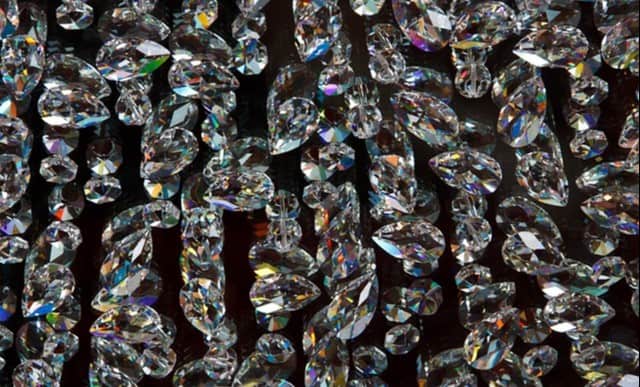
What are some of the misconceptions about chips?
Beliefs that people develop by listening to rumors or exceptional actions can highly affect understanding. Here are some of the myths regarding chips of diamonds.
- It is impossible!
Yes, a lot of people believe that diamond being the hardest substance, cannot chip. But we know, that is not true!
- Crack on diamonds
Many people who encountered the chip for the first time thought it to be a crack in the diamond. But it is normally a chip on the surface.
- It is always possible to salvage by re-cutting the diamond
While in some cases you can recut and salvage the diamond, it is not always possible. If your diamond is already very small, recutting can be highly challenging and costly. At times, diamond may also shatter if it is already very weak and you try to recut it.
- Insurance will cover it
Some diamond owners believe that their home owner’s insurance will cover a damage to their diamond. While it may cover a theft, it will certainly not cover a chip. You need to go for personalized jewelry insurance that covers damage to stone.
- Only hard blows can chip a diamond
It is mostly true, but not always. If your diamond has stress build up, only a gentle tap on a hard surface can chip it.
- A chipped diamond cannot be worn
A lot of diamond owners feel that they cannot wear their diamond any longer if it is chipped. We know that’s not true. We have discussed above, it is possible to wear your chipped diamond, sometimes even without repairing it. Not just that, a lot of people deliberately buy chipped diamonds and wear them as they do not cost an arm and a leg.
Conclusion
Diamonds score exactly 10 on the Mohs Scale of hardness and are 4 times harder than Corundum, the second hardest mineral. But despite the fact that diamonds are the hardest known gemstone, and one of the rarest resources available on earth, they can be so vulnerable. This is because a lot of man made materials can be stronger than diamond. E.g. Tungsten being really strong can break diamond if the right force is applied. This implies, sudden impacts can compromise the structural integrity of your diamond. Hence, it is best to take care of it before unexpected situations arise. Even if it does, there are ways to deal with it that we discussed above. I hope you are able to reuse your chipped diamond or get the best value for it.
Until next time! Cheers! 🙂

